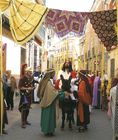
In the northwest of the Murcia Region, bordering the Autonomous Region of Valencia and Castilla-La Mancha, we find Jumilla.
To Know Jumilla means to get into a trip that will lead travelers to prehistoric, Romans, Muslims or Christian periods. The Renaissance or the Baroque leaved trace in its architecture, an evidence of it is the church Mayor de Santiago or the one in El Salvador, respectively. The city
Its old streets, twisted and distinguished, figure the immense legacy of Castilla and Levante, which have conformed its physiognomy and people. From its historic center we must highlight the parish church Mayor de Santiago, symbol of the city. It belongs to the latest Gothic and it was constructed thanks to the contributions of the wealthy families of Jumilla of the XV century. From the religious architecture we must also highlight the church of El Salvador, sample of the baroque of Murcia; the Chapel of San Antón; the parish church of Santa María del Arrabal, built in 1430 over an Islamic necropolis; the monastery of Santa Ana del Monte; and the chapels of San José and San Roque, known more as Doors of Granada. We must also mention the Chapel of San Agustín, which marks the barrier between the countryside and the city. Inside we find the image of the patron, Nuestra Señora de la Asunción. The salomonic columns of the ancient Council trick the traveler to the following stop of this monumental route. The building is the only sample of civil architecture from the Renaissance of Murcia. The Casón, funerary building from the late Roman period was declared National Monument in 1931, it is the best preserved building of the whole Spain. Inside of it there are still today three sarcophagi. The Town Hall is another of the jewels of the city, even if it was built in 1583 to be used as a hospital. The traveler must also visit the Vico Theater, the Castle-Fortress, the Tower of Rico or the Cuco de la Alberquilla.
|




 Ayuntamiento de Jumilla
Ayuntamiento de Jumilla









